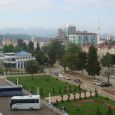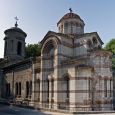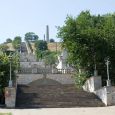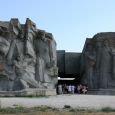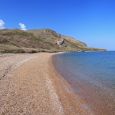Kerch
Advertisement
By Air
Powered national airline Kerch.In addition to the city airport, 18 km from the city airport complex is Baherove that can accept the aircraft, civil and military aircraft of all types.
By Train
The railroad terminals include: Kerch, Kerch I, Kerch Factory, Arshyntsevo, and Krym.Kerch has a railway station.Also you can get a sleeper train from Kyiv.It's possible to get a cheap sleeper train from Kerch to Sevastopol.
By Bus
There are frequent buses to and from other desitinations in Crimea.Bus network connects Kerch to other cities in Crimea and Krasnodar Krai.The main public transport city - buses and trolleybuses.Before the Second World War acted in a tram.
By Ferry
Kerch has a harbour on the Kerch Strait, which makes it a key to the Sea of Azov, several railroad terminals and a small airport. Ferry transportation across the Kerch Strait was established in 1953, connecting Crimea and the Krasnodar Krai (Port Krym - Port Kavkaz line); (as of November 2009) there are also plans for a Kerch-Poti ferry route.There are several ports in Kerch, including Kerch Maritime Trading Port, Kerch Maritime Fishing Port, Port Krym (ferry crossing), Kamysh-Burun Port.
Panticapaeum
an important city and port in Taurica (Tauric Chersonese), situated on a hill (Mt. Mithridates) on the western side of the Cimmerian Bosporus, founded by Milesians in the late 7th–early 6th century BC.During the first centuries of the city's existence, imported Greek articles predominated: pottery (see Kerch Style), terracottas and metal objects, probably from workshops in Rhodes, Corinth, Samos and Athens.Local production, imitated from the models was carried on at the same time.Athens manufactured a special type of bowl for the city known as Kerch ware.Local potters imitated the Hellenistic bowls known as the Gnathia style as well as relief wares Megarian bowls.The city minted silver coins from the mid 6th century BC and from the 1st century BC gold and bronze coins.The Hermitage and Kerch Museums contain material from the site, which is still being excavated.In the 5th–4th centuries BC, the city became the residence first of the Archaeanactids and then of the Spartocids, dynasties of Thracian kings of Bosporus, and was hence itself sometimes called Bosporus.Its economic decline in the 4th–3rd centuries BC was the result of the Sarmatian conquest of the steppes and the growing competition of Egyptian grain.The last of the Spartocids, Paerisades V, apparently left his realm to Mithridates VI Eupator, king of Pontus.
Mount Mithridat
located at the city center of Kerch, Ukraine, was one of the nominees for the seven wonders of Ukraine.To the top of the mountain with the height of over 90 m (91.4 m) leads the Great Mithridates Staircase in a series of flights and balustraded terraces, which was built in 1833-40 by the Italian architect Alexander Digbi.A well-built road goes all the way to the top.The mountain is named after Mithridates VI of Pontus, ruler of the Kingdom of Bosporus; for a long time he stood up to the great Roman Empire until he was deceived by his own son.After a long siege of Panticapaeum he tried to kill himself several times until finally was killed by the leader of his own guardsmen.From the top of the mountain spreads a scenic outlook across the Strait of Kerch and the city.Sometimes it is possible to see the Caucasus shore.In the 19th century a museum was erected on the top of the mountain in the form of a Greek temple, but it was destroyed during the Crimean War.In 1944 the obelisk was built to commemorate the soldiers that defended Kerch in World War II.
Fortress of Yenikale
is a fortress on the shore of Kerch Strait near Kerch city (Crimea, Ukraine).Yeni-Kale was built by Ottoman Turks in 1699–1706 on the Kerch peninsula that belonged to the Crimean Khanate.The name Yenikale means New Fortress in Turkish (yeni - new, kale - fortress).The fortress was built under the guidance of Goloppo, who was an Italian convert to Islam.Several French engineers also took part in the construction.Yeni-Kale was armed with powerful cannons and took an important strategical place on the coast of Kerch Strait.The fortress occupied area of 25,000 m2 and had two powder-magazines, arsenal, water reservoir, living houses, bath-house and mosque.About 800 Turkish and 300 Crimean Tatar soldiers were garrisoned in Yeni-Kale.The weak spot of the fortress was a lack of drinking water in the area, so an underground water-pipe was made to bring water from a source located several kilometres away from the fortress.Yeni-Kale was served as a residence of pasha.Today ruins of Yeni-Kale is often visited by tourists.The neighboring district of Kerch also is named Yeni-Kale.
Defense of the Adzhimushkay quarry
was an action on the Eastern Front in World War II that occurred between May and October 1942.Adzhimushkay is a small village located five kilometers from the city of Kerch, near which a complex network of catacombs is located.Limestone was extracted there from 1830, both from the quarry and the catacombs.Over the years an underground network was created, encompassing the Great and Small Adzhimushkay catacombs.They were used during the Russian Civil War by pro-Soviet armed groups.When Kerch was first occupied by the Wehrmacht in November 1941, a squad of partisans operated in the catacombs.By May 1942, a massive counteroffensive was staged by the Wehrmacht in order to expel the Red Army both from the Kerch Peninsula and the city of Sevastopol.The Soviet high command had neglected to build comprehensive defenses; the Red Army was overrun and had to flee, sustaining heavy casualties.By May 19, 1942 the battle was over.This dramatic event was heavily popularized after the war.Several books and songs were written to commemorate it.A museum was erected in the catacombs in 1966 and a memorial in 1982.
Church of John the Baptist
belongs to the oldest sacred buildings missing samples of Byzantium, the Crimea, modern Ukraine.Past the temple for centuries pilgrims walked, and the inhabitants of different countries, not knowing about the existence of the temple, the age which reached deep into the ages.At the altar of unusual noticed late 1980s during the repair of the church in 1757 Thick layers tynku made altar of the church like a village, completely hiding its original appearance and shape.During the restoration removed about 1 meter later accretions.Buildings facing roofs with tiles for historical analogies.The interior of the metal beams strengthened because of the danger of destruction of the ancient sacred temples of the Crimea and Ukraine.Scientists date of the eighth century BC (8 century BC)Territory ordered, laid stone pavers, landscaping held areas.
April - July
September - February


